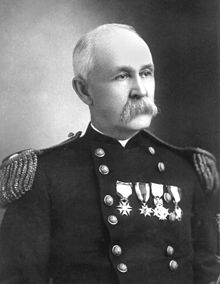George Miller Sternberg | |
|---|---|
 Brigadier General George Miller Sternberg | |
| Born | June 8, 1838 Otsego County, New York |
| Died | November 3, 1915 (aged 77) Washington, D.C. |
| Buried | |
| Allegiance | United States of America |
| Service/ | United States Army |
| Years of service | 1861–1902 |
| Rank | Brigadier General |
| Commands | U.S. Army Surgeon General |
| Battles/wars | American Civil War Spanish–American War |
Brigadier General George Miller Sternberg (June 8, 1838 – November 3, 1915) was a U.S. Army physician who is considered the first American bacteriologist, having written Manual of Bacteriology (1892).[1] After he survived typhoid and yellow fever, Sternberg documented the cause of malaria (1881), discovered the cause of lobar pneumonia (1881), and confirmed the roles of the bacilli of tuberculosis and typhoid fever (1886).[2]
As the 18th U.S. Army Surgeon General, from 1893 to 1902, Sternberg led commissions to control typhoid and yellow fever, along with his subordinate Major Walter Reed. Sternberg also oversaw the establishment of the Army Medical School (1893; now the Walter Reed Army Institute of Research) and of the U.S. Army Nurse Corps (1901). The pioneering German bacteriologist Robert Koch honored Sternberg with the sobriquet, "Father of American Bacteriology".[3]
- ^ Flaumenhaft, E; Flaumenhaft, C (1993). "Evolution of America's pioneer bacteriologist: George M. Sternberg's formative years". Military Medicine. 158 (7): 448–57. doi:10.1093/milmed/158.7.448. PMID 8351046.
- ^ Malkin, HM (1993). "The trials and tribulations of George Miller Sternberg (1838–1915) – America's first bacteriologist". Perspectives in Biology and Medicine. 36 (4): 666–78. doi:10.1353/pbm.1993.0068. PMID 8361848. S2CID 28424585.
- ^ Sherlock, Tom (2013). Colorado's Healthcare Heritage: A Chronology of the Nineteenth and Twentieth Centuries. Bloomington, IN: Iuniverse Com. p. 368. ISBN 978-1-4759-8025-7.